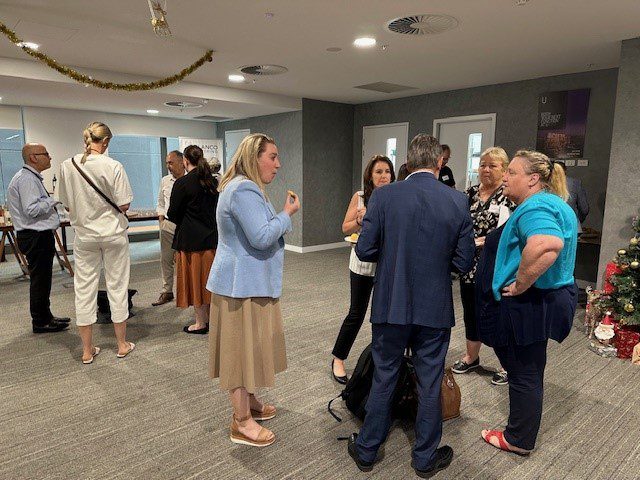INTRODUCTION
Welcome to our last Newsletter and Case Update for 2023, where we aim to keep you up to date with all that is happening in the law affecting workplaces, and with what we’ve been doing here at KJK Legal.
In this edition, we will summarise some of the major events we have been involved in this year, bringing you up to date with some significant changes in various workplace laws, and in the spirit of the season and where many of you are looking to wind down, we will endeavour to keep the technical analysis of recent legal cases to a minimum!
Firm News
We actually had lots to talk about over the last six months, which has been an exciting time for the firm in many respects. Some of the highlights from the second half of this year include:

We welcomed Chrissy Psevdos to the firm on 1 July 2023. Chrissy is a solicitor of longstanding experience, having walked “both sides of the fence” in the workers compensation industry. She has been appointed as our first Special Counsel, and we hope many of you have taken the opportunity to meet with her, or have already been the recipient of her always well considered and accurate practical legal advice in recent months!

In terms of staff numbers at KJK Legal, we also welcomed on-board as a permanent employee our Assistant Finance Officer, Fiona Feist. Fiona comes to us with many years of experience, and a calm and steady demeanour, which is always an asset when dealing with some of our firm’s personalities!

Our team numbers were also bolstered by the fact that Senior Associate Suzana Jovanovic gave birth to her son Dejan in August 2023, and we look forward to welcoming Dejan as a law clerk in the years to come!

We are pleased to be able to say we have continued to be recognised as one of Adelaide’s leading workplace law firms by the well renowned and industry recognised Doyle’s Guide. In 2023 we have maintained our accreditation in the areas of workers compensation, work health and safety, and dust diseases work, and with Tracey Kerrigan, Neville John, Chrissy Psevdos, and Mark Keam all being recognised individually in their respective fields of practice.

We continued with our regular seminar / webinar series in December 2023, again taking the opportunity to use our client Uniting Communities terrific function room to put on an event for the benefit of our clients and contacts. Tracey Kerrigan and Chrissy Psevdos presented on aspects of the Section 22 permanent impairment process. Feedback from those attending either in-person or online, was, as always, positive, and we look forward to continuing to provide value to you, and useful insights into workers compensation claims management process in the new year. As a reminder to you all, our various webinars and presentation papers / PowerPoint slides are available, either via our website or our YouTube channel.
The Supreme Court further addresses the impairment assessment / combination issue
Commentator: Chrissy Psevdos
After much anticipation, the Court of Appeal of the Supreme Court of South Australia delivered their judgment in the matter of Return to Work Corporation (SA) v English and Williams v Return to Work Corporation (SA) [2023] SASCA 125.
Both cases required further interpretation of Section 22(8)(c) beyond that already considered in the matter of Summerfield specifically with respect to dealing with impairments arising from a fall due to the effects of medication taken for a work injury (English) and impairments that arose from repetitive work activities over a period of time (Williams).
The Facts
Mr English suffered a work injury to his neck in March 2019. In May 2019 he suffered a further work injury when he fell and injured his right quadriceps. The fall occurred as a result of light-headedness caused by prescribed pain medication (Lyrica) Mr English was taking for his neck injury. Both lots of injuries were accepted as compensable.
The Return to Work Corporation chose not to combine the impairments relating to his two injuries when determining his entitlements under s22 of the RTW Act on the basis the injuries did not arise “from the same injury or cause”.
Mr Williams worked as an electrician. From early 2015, he was required to do more physically demanding work, including having to climb up and down ladders and stairs frequently, and do more work in a crouched or kneeling position.
Over time, Mr Williams suffered increasing pain in both knees, undergoing surgery on both. He made a claim for lump sum payments under s58 of the RTW Act, but the Return to Work Corporation chose to not combine his two knee injuries when determining his entitlements, once again taking the position that they did not arise “from the same injury or cause”.
Findings
In English, the Court of Appeal delivered a majority decision, with Justices Doyle and Bleby agreeing the injuries could be combined. Chief Justice Kourakis was in dissent.
Justices Doyle and Bleby found both impairments arose from the same injury (the initial neck injury), and from the same cause (the event that caused the initial neck injury or, indeed, the neck injury itself) and so were to be combined, despite the second impairment not being physiologically linked to the first impairment.
The dissenting opinion of Chief Justice Kourakis supported the contention combination under Section 22(8)(c) required the impairments have their origin in, and progress from (in the sense of being aetiologically linked to), the same cause.
In Williams, the Court was unanimous the left and right knee injury Mr Williams sustained should be combined. They found Section 22 wasn’t just limited to subsequent injuries arising from the initial injury – but that it extended to the combination of impairments from multiple injuries that both arose from the same incident or event. In other words, both knee injuries were caused by the regular climbing and crouching Mr Williams was required to perform between May and August 2015 in the course of his employment, thus making them one and the same.
At paragraph 139 of the decision, Justice Bleby emphasised the case law as follows:
“In my view, it is neither possible or appropriate to be any more prescriptive than Stanley J in Summerfield. In determining whether the impairments are to be combined under s22(8)(c) in assessing an injured worker’s WPI, the issue is whether the impairments are “from the same injury or cause”. In considering whether a later impairment qualifies for combination, it is necessary to consider the causal explanation for each of the impairments, in order to determine whether these explanations possess the requisite sameness. This requires an evaluative assessment of the causal explanations, and in particular any difference between them. It requires an evaluative assessment of whether any additional events or integers in the causal explanations are of a nature or significance that means that the impairments cannot be said to arise from the same injury or case.”
In terms of undertaking any evaluative test, we note Justice Bleby provided the following comment at paragraph 140:
“I see no difficulty in adding that the evaluative assessment will be informed by common sense, as long as it is understood that this is not to suggest that common sense is the criterion or touchstone by which the requisite sameness is to be determined. Equally I would add that the evaluative assessment is to be approached in a practical manner focusing upon the substance of the causal explanations for the relevant impairments. It is not to be approached in a manner that is overly technical or artificial.”
The future of combination
The dissenting judgment of Chief Justice Kourakis does give some merit to the argument that medication induced impairments ought to be a step removed from the original incident or event, despite the majority not sharing this view, it still remains important to consider the facts on a case-by-case basis.
One of the few situations where multiple sequential injuries and impairments might still be put into argument is where a later injury is partly associated with a prior injury, but also partly due to an actual later event – e.g. a worker developing problems with a non-injured left shoulder due to its overuse following earlier injury to the right shoulder, but then falling onto that left shoulder and suffering much greater injury. At least an ability to disregard an element of the whole later injury and impairment might arise, or indeed the later injury from the fall may completely overwhelm what might have existed in the shoulder in any event.
Therefore, when applying the evaluative assessment that is required in these cases, one should approach matters in a practical manner, focusing upon the substance of the causal explanations for the relevant impairments.
Important employment law industrial changes effective in December 2023 and January 2024
Commentator: Matilda Wise
Before we kick off with a reminder of pending changes in the employment law space, we also confirm having addressed a lot of the then pending changes in our June newsletter. You may find it helpful to review that newsletter (available on our website) to refresh yourself with the many changes that occurred in the second half of this year.
Fixed Term Contract changes
There are a number of changes to the use of fixed terms contracts which started as of 6 December 2023. The first change is employers with employees on fixed term contracts must provide the employee with a Fixed Term Contract Information Statement. This Statement outlines the rules about fixed term contracts and the protections in place for employees.
There will also be limitations on fixed term contracts made on or after 6 December 2023. These limitations include:
- they cannot be for longer than 2 years;
- they cannot have an option to renew or extend past 2 years; and
- consecutive fixed term contracts cannot be offered if there is similarity in the employment relationship between the contracts.
However, there are number of exceptions to these limitations, including employing those with a specialised skills for a specific task, training arrangements, positions subject to government funding, governance positions, and high-income employees.
Zombie Agreements automatically terminated
As of 7 December 2023, all zombie employment agreements (pre 2010 agreements) cease to operate, unless an application to extend the agreement was made prior to 7 December 2023. This is because Zombie Agreements do not reflect modern day expectations and their contents would not be approved as part of an enterprise agreement in 2023. Zombie Agreements have easily identifiable features such as the name of the agreement containing the words collective agreement or workplace agreement, if it references the Workplace Relations Act 1996 (Cth) or other repealed legislation, if the agreement is dated 2009 or earlier. Once the Zombie Agreement is terminated, employees covered under the agreement will be automatically covered under the relevant modern award.
Positive duty under the Sex Discrimination Act 1984
Commencing 12 December 2023, the Australian Human Rights Commission (“the Commission”) has the power to enforce the employer’s positive duty to eliminate sexual harassment in the workplace in accordance with the Sex Discrimination Act 1984. If the Commission reasonably suspects non-compliance, they have powers to conduct enquires into the employer and their practices. If they find the employer has not been exercising its positive duty, then the Commission can enter into agreements with the employer or issue a non-compliance notice which can be enforced by a court.
Superannuation changes
From 1 January 2024, all employees will have the right to receive superannuation contributions under the National Employment Standards. This means that non-compliance with this standard is a breach of the Act, and action can be brought for such breaches by employees, unions, or the Fair Work Ombudsman. The primary enforcer and regulator of employer superannuation compliance will continue to be the ATO.
For any queries you might have about these changes, and those discussed in out June newsletter please feel free to reach out to Neville John (njohn@kjklegal.com.au) or Tilly Wise (mwise@kjklegal.com.au), our employment law specialists.
Section 18 Update
As you would all be aware, the South Australian government sought submissions on proposed amendments to Section 18 of the Return to Work Act. After a flurry of activity amongst stakeholders in the lodging of submissions, things have gone quiet, and with the rising of parliament now at the end of 2023, it is highly unlikely we will see any proposed legislation arising from the review until well into next year. If anyone has heard the beating jungle drums insofar as what the government might adopt, reject, or reconsider and vary, then we are all ears!
Review of the Impairment Assessment Guidelines
In a similar vein, a review has been conducted of the Impairment Assessment Guidelines, with a government appointed panel having looked into the issue over the last six or so months. Our impression is that the timeline for the completion of the review has blown out significantly, and so it remains to be seen what will happen with the review outcome, and when it might happen. Again, this is now much more likely to be a matter that will come into consideration well into next year.
A grab bag of interesting South Australian Employment Tribunal decisions
If you are a keen reader of South Australian Employment Tribunal (“SAET“) decisions, you will know the rate of actual decision making by the SAET has slowed significantly over the last year or two. This is probably not something we can still blame on COVID-19. It is more a reflection of the maturing of the current legislative scheme, and the fact many of the previously uncertain legal issues have now been thrashed out at various levels of the court system, including ongoing, but now very occasional, consideration of issues by the Court of Appeal.
In that case, it is perhaps now the more narrow issues that might start gathering attention, rather than the big picture issues such as the effect of the transitional provisions or combination of impairment question. With that in mind, here is a selection of interesting cases which throw up some useful case management considerations for you moving forward.
Piontecki v RTWSA [2023] SAET 92
Topic: The ability to expand the basis for issuing a Section 48 Notice
Commentator: Mark Keam
Historically, a compensating authority seeking to rely upon a Section 48 Notice was largely constrained to the grounds on which the Notice might have been issued in the first place, e.g. adding a breach of mutuality argument later on to a Notice relying on a worker having been certified as ceased to be incapacitated for work was not considered permissible. However, in the decision at hand the SAET has seemingly set the scene to enable a much broader basis for asserting an entitlement to cease weekly payments can be pursued, even at a point well into the applicable litigation.
In this matter, the compensating authority sought to contend at judicial level they could assert weekly payments should be ceased because of certain facts constituting a breach of the worker’s obligation of mutuality, in addition to the initial assertion in the notice the worker had ceased to be incapacitated for work by his work injury. The SAET permitted this course of action, where the compensating authority sought to raise it as part of its Statement of Facts, Issues and Contentions to be lodged in preparation for judicial hearing and determination of the case, i.e. at a time post the conciliation process having concluded. The SAET found they were not constrained to determine the dispute on a narrow view of the basis on which weekly payments might be ceased, and as long as due process was followed and notice given, then permission might be granted to effectively enlarge the scope of the proceedings (without following that particularly formal process outlined under the South Australian Employment Tribunal Act).
Of course, in any situation where this scenario might arise, the earlier the matter is raised with the opposing party the better. It is not something that will probably be permitted if raised on the doorstep of court.
Hill v RTWSA [2023] SAET 93
Topic: Dealing with leave entitlements at the time of Consent Orders for back pay
Commentator: Mark Keam
In an area that seems to create endless confusion, albeit also an area that is rarely litigated, a question arose as to whether certain personal and annual leave entitlements accessed by the worker during a period of what eventually became an entitlement to weekly payments, could be deducted from the entitlement that was being determined by way of Consent Orders. In the case at hand, there had been no specific reference to any taking into account of such leave payments, such as any form of offset arrangement in the proposed Consent Orders.
In the absence of any express provision dealing with the issue, the SAET found that if a worker elected to press a claim for weekly payments, and not have their leave entitlements offset, then they were fully entitled to do so. Part of the rationale for this was that if the worker chooses to effectively “burn” their future leave entitlements at the same time as receiving weekly payments, then so be it. The SAET also noted there had been an amendment to the wording of the relevant provision (Section 40) in 2015 to the effect that now the provision deals with “annual or other leave” (all encompassing?) rather than previously “annual leave or long service leave”.
While the SAET outlined the rationale behind the provision concerned, and that it is not truly a case of “double dipping”, it would be mindful to give consideration to whether a specific agreement needs to be made in certain circumstances. For example, if the resolution of the matter of a claim for weekly payments is part of an overall settlement, which involves resignation, then it is normally a situation where the departing employee does not take with them their sick leave, and so that might be something that is specifically carved out from any agreement as to weekly payments, insofar as the weekly payments might not be reduced for any annual or long service leave access during the period concerned, but not so as it concerns sick leave, which is not ordinarily paid out on resignation.
Nedza v RTWSA [2023] SAET 103
Topic: Settlement enforceability – going beyond agreeing something “in principle”
Commentator: Mark Keam
This case is an important one to read for anyone contemplating on reaching agreement at conciliation, and where they might be concerned that any such agreement might not necessarily “stick” down the track. The case deals with the differing levels of what might be called a “binding” agreement that is reached as part of a settlement / conciliation process, and where any such agreement can later be enforced, notwithstanding that one party might try to withdraw from the agreement reached.
On many occasions the parties will conclude a conciliation process at the SAET having agreed something “in principle”, and then go off to prepare settlement documents. Sometimes the actual terms of the contents of the settlement documents will be agreed in detail at the time the conference concludes. Sometimes they won’t. Sometimes they might be recorded before the Commissioner concerned, or even a judge conducting a judicial settlement conference, but sometimes they won’t.
If there is to be any doubt as to whether a settlement might be binding on all parties, then the more detail that is recorded in writing between the parties on the day the agreement is reached, the better, in terms of being able to enforce the agreement against a later recalcitrant litigant. Any such agreement that is recorded can extend to terms both within the parameters of the dispute itself, and the Return to Work Act, as well as broader employment considerations. The whole intention is to have as much of the aspects of the settlement as negotiated to be recorded, so that there can be little doubt down the track as to what the parties intended as to the final agreement that was reached, and where the documentation that might yet be prepared is simply a reflection of that broad agreement as reached, rather than going away and endeavouring to put into effect a simple overarching and in principle agreement to pay a certain sum of money, with terms to be agreed later. The enforcement of an agreement in the latter terms will be much more problematic than one which is recorded in detail, and on the day.
Updated Precedents are now available
For those of you who use them, we have updated our precedent workers compensation documents, which are available upon free subscription for our clients, and for a very modest fee for our contacts. Please visit our website to sign-up in this regard. We are slowly also working through some of the key SISA documents for updating and adding to our own precedent document suite. We will keep you informed as the SISA precedent documents are finalised and added to our database.
Into the future
While we look forward to 2024, and continuing to provide you with what we hope is an excellent standard of service and pragmatic cost effective legal advice, things cannot always remain the same! We continually review what we do, and how we do it. Whether we will suddenly decide that providing legal advice by way of AI and Chat-GPT is the way to go remains doubtful, but change is inevitable!
One of the things that we will probably look to review into the new year is the way in which we present our seminars and webinars to you. We are gaining good traction in the internet space, insofar as many people are logging on to our webinars. However, we have encountered ongoing problems with seminar attendance, not so much from the number of registrants, but the number of registrants who either cancel their attendance on the day of the seminar, or simply do not turn up.
We have been historically prepared to put on these events at our own cost, which on occasion can run to thousands of dollars, and therefore to find that we end up with attendee numbers at events well under the RSVP indicative numbers costs us money. We have never sought to charge for people’s attendance at our seminars, and certainly would never wish to do so in the future. It is therefore likely that moving forward we will now simply transition to only presenting webinars to you all, and hope that you will understand our reasoning in doing so. As always, our webinars can be viewed either on the day and in an interactive fashion via Zoom, or by viewing at a later time and at your convenience through our website or our YouTube channel.
On a final note, we take this opportunity to again thank you for your patronage of our firm over the last year, and wish you a happy and safe festive season. We look forward to seeing you all again in 2024.
As always, should you have any questions, queries, feedback or comment on anything we’ve discussed above, or advice on any workplace legal needs, then please don’t hesitate to reach out to one of us.
If you wish to undertake further reading in relation to any of the decisions discussed, they can be found at www.austlii.edu.au.
Mark Keam – Editor

